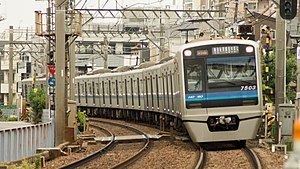Native name 北総線 Opened March 9, 1979 Character Double track | Operator(s) Hokusō Railway Stations 15 | |
 | ||
Owner Hokusō Railway (between Keisei-Takasago and Komuro; Category 1)Chiba New Town Railway (between Komuro and Inba-Nihon-Idai; Category 3) Terminis Keisei-Takasago Station, Inba-Nihon-Idai Station | ||
The Hokusō Line (北総線, Hokusō-sen) is a commuter rail line operated by the third-sector Hokusō Railway in Japan. It runs between Keisei-Takasago Station in Katsushika, Tokyo and Inba-Nihon-Idai Station in Inzai, Chiba. It is part of the primary Keisei route between central Tokyo and Narita International Airport through the Narita Sky Access Line. It uses the ATS Type 1 system.
Contents
Operations
Most trains are all-station "Local" services, but some limited-stop "Rapid" express trains have operated in morning and evening hours.
Hokuso Railway
Chiba New Town Railway
Keisei Electric Railway
Keikyu
Toei Subway
Hokuso Railway
Shin-Keisei Electric Railway
Keisei Electric Railway
Toei Subway
Keikyu
History
The first section of the line, from Komuro to Shin-Kamagaya, opened in March 1979, including a temporary connection to the Shin-Keisei Line at Kita-Hatsutomi. As other tracks were connected, it changed name to "Hokusō Kōdan Line" in April 1987. Over 17 years later, the railway properties of the HDC corporation transferred to Chiba New Town Railway (千葉ニュータウン鉄道, Chiba Nyūtaun Tetsudō), on July 1, 2004, and the whole line was renamed as the Hokusō Line.
Western section
This section was planned as a railway access to Chiba New Town. Initially proposed by a committee of the then Ministry of Transport, the route was numbered "Line 1", as the northern extension of Tokyo Metropolitan Bureau of Transportation (Toei) Line 1 (present Asakusa Line) to Komuro area of Chiba New Town. In 1979 the first phase of this section between Kita-Hatsutomi and Komuro opened. The through-operation via Shin-Keisei Line to Matsudo began, on a temporary basis until the second phase of this section could connect the town directly to the Keisei and Asakusa Line network.
The second phase section to Keisei-Takasago on Keisei Main Line opened in 1991, and through-operation began. In the following year, Shin-Keisei included Shin-Kamagaya Station as a transfer station, and abandoned the temporary route.
Eastern section
The section east of Komuro was initially the eastern part of a once-planned Chiba Prefectural Railway (千葉県営鉄道, Chiba Ken'ei Tetsudō) (II, apart from the first which opened the Tōbu Noda Line and the Kururi Line) as an extension of Line 10 (Shinjuku Line). The line was to be built from Motoyawata via Komuro to parallel to the line above, then to terminate at present Inba-Nihon-Idai. The first section between Komuro and Chiba New Town Chūō was opened in 1984, and the operations were commissioned to the present Hokusō Railway.
Extension to Narita Airport
After the abandonment of the planned Narita Shinkansen, routes of rapid transit to Narita Airport had long been discussed. For a utilization of partially completed tracks of the Shinkansen, JR East and Keisei lines to Narita Airport were realized. A much faster line had long been needed, and for that purpose the first priority was the Keisei – Hokusō route. In 2001, a new Cat-3 entity, Narita Rapid Rail Access (成田高速鉄道アクセス, Narita Kōsoku Tetsudō Access) commenced building a new line connecting Inba-Nihon-Idai to the junction to Narita Airport Rapid Railway (成田空港高速鉄道, Narita Kūkō Kōsoku Tetsudō) which is a Cat-3 company of existing access railways, the tracks of the formerly planned Narita Shinkansen. The express trains are operated by Keisei as a Cat-2 operator with maximum speed at 160 kilometres per hour (99 mph), the fastest in Japanese private railway together with Hokuetsu Express, which enables a 34-minute journey from Nippori to Narita Airport. The line opened in July 2010.
Local subsidies
Hokuso Railway fares are significantly higher than those of other private railways in the region. A journey of 12.7 km on the Hokuso Line costs 540 yen, while a 23.8 km journey costs 720 yen. Equivalent journeys on the Keisei Main Line cost 250 yen and 360 yen respectively; equivalent journeys on JR cost 210 yen and 380 yen respectively. The difference in fares is largely due to the debt burden remaining from the portion of the line built and owned by Hokuso Railway itself; this is also the case for the Tōyō Rapid Railway Line and the Saitama Rapid Railway Line, which are also known for having comparatively high fares.
In 2009, Chiba Prefecture and several municipalities along the line agreed with Hokuso Railway for an average fare reduction of 4.6% (25% for student commuter passes), in exchange for which they agreed to subsidize half of the estimated revenue loss of 600 million yen. The fare reduction was implemented in July 2010 at the time of the opening of the Narita Sky Access Line. In 2011 and 2012, the cities of Shiroi and Inzai elected new mayors on platforms of negotiating for further fare reductions and stopping public subsidies respectively; a third-party study commissioned by the two city governments concluded in August 2013 that the Hokuso line would break at even more discounted fare levels without local subsidies. Hokuso, on the other hand, has argued that increased consumption tax rates and capital expenditures related to upgrading the Pasmo system will force them to raise fares in 2015.
